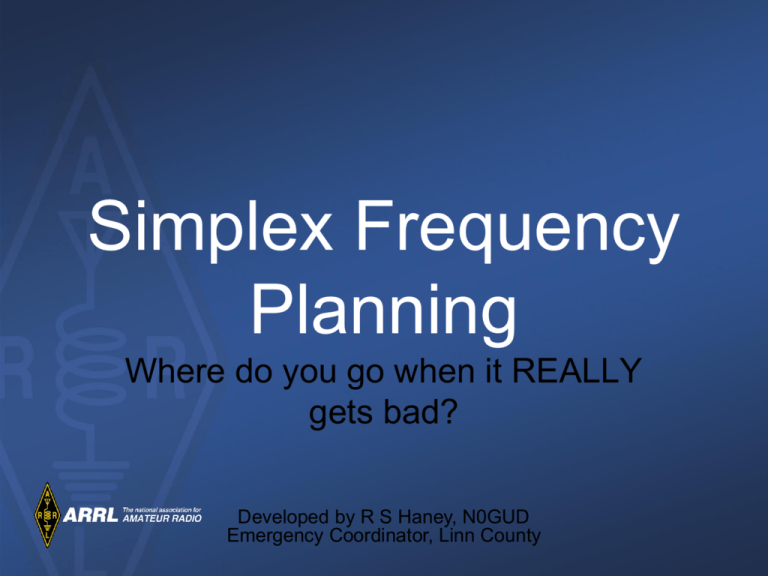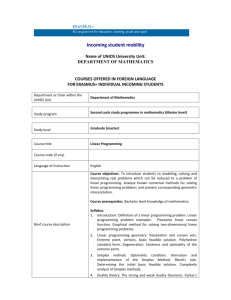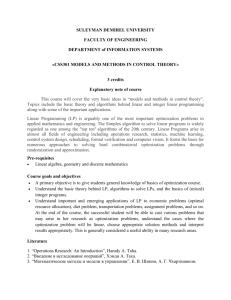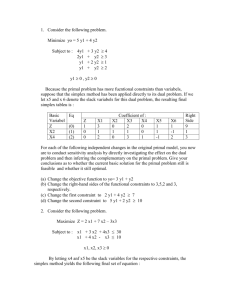Planning Simplex Frequencies
advertisement

Simplex Frequency Planning Where do you go when it REALLY gets bad? Developed by R S Haney, N0GUD Emergency Coordinator, Linn County Why does this matter? Three Basic Rules for Emergency Preparedness 1. Have a plan. 2. Exercise that plan. 3. It will NEVER go according to plan. Rule 3 does not cancel out the other two! Very Funny! But… These rules actually make sense! • Our plans give us a common starting point. • Without a plan, you are guaranteed to fail! You need to start together. • This includes knowing where to go when our own infrastructure is damaged. Repeaters • They’re awesome! So much so, Iowa apparently has no 2m frequency pairs left in the coordination pool. • Many are highly reliable, but they can be damaged or taken off line, just like the public systems we try to supplement. • In Linn County, we have two repeaters in the plan, and a third readily available, all of which are tied to a single tower... Repeaters (cont’d) So what can we do when the repeater goes down? 1. Move to the next repeater in the list, if it’s there. 2. Move to the planned simplex frequency if the planned repeaters are down. 3. Go simplex on the repeater outputs. I do not recommend option 3…. Why not use the outputs? Two main reasons: 1. Not everyone was able to readily switch their gear over to simplex. (Some radios will turn the offset back on if you leave the frequency and then return.) 2. The repeaters were actually up and down several times, making it difficult to know if simplex or duplex should be used. The confusion caused some problems. Fortunately, we were able to switch to other systems. Benefits of Simplex Planning • Having simplex in the plan helps to guide people on their radio programming. Programming a new frequency on the fly is suboptimal. Better to have it in advance. • Publishing a “standard memory loadset” is almost always appreciated! • It also flags certain frequencies as being likely for any local public service events. Choosing Frequencies • You can use any marked as simplex in the band plan! (Except the national call frequency, of course.) • For 2m, these are 146.000-146.595 and 147.405147.585, which work well with the 15 kHz spacing common in Iowa. • BUT be aware of local use customs, such as packet clusters or repeaters. How many? • Most counties really only need one in the plan. • More active areas should consider planning TWO due to traffic levels. • But they shouldn’t be too close! Linn was using 146.505 and 146.460, which caused problems with colocated NCS. (Fortunately, WA9ENA has a solution to this….) Frequency Coordination • Linn County has a working nuclear power plant. The response plan for it includes multi-county activation, which is exercised regularly. • As such, we needed a way to coordinate the choices counties make to avoid or minimize interference with each other. • Worked out a way to do this reliably, but not everyone was thrilled with the idea. Frequency Coordination What Coordination Is A means of making sure we are not interfering with each other during rapid deployments What Coordination Is Not An effort by anyone to tell you what to do! Coordination Issues • Most of Iowa should be fine with no coordination. Some areas may be better served with one frequency for multiple counties. • More active areas should consider having no two neighboring counties on the same frequency. • Some areas (like District 6) may need even stronger restrictions due to multi-county deployments. DO WHAT WORKS! How We Coordinate • Short answer: MATH (this is the part where my daughter would say NERRRRRRD) • Longer answer: Keeping neighbors from having the same frequency is equivalent to a map coloring problem, which means we can coordinate all 99 counties with only 4 frequencies out of the 26 available. Plenty of room! • I wrote some software to do this given a map definition. BUT…. How We Coordinate • In District 6, we not only need to not share with a neighbor, but also not with neighbors of neighbors. • Example: If Jones and Benton use the same frequency, they can’t hear each other, but Linn will hear both, and potentially can’t talk to one without interfering with the other. • This required modifying my Iowa map, which resulted in a three-dimensional model! That meant that four frequencies was not guaranteed How We Coordinate • Fortunately, was still able to coordinate the entire state with the D6 modifications using only 9 or 10 frequencies. • Also found a way to mark counties that already have preferred frequencies, so nobody has to move. • This is not guaranteed to work, but as far as I can tell, only four counties have defined simplex frequencies, so no problem. Summary We encourage everyone to write a simplex frequency into their plans. It’s not REQUIRED that you do so, but it can’t hurt. If you do and want coordination, let N0GUD know. He actually enjoys the math. Questions








